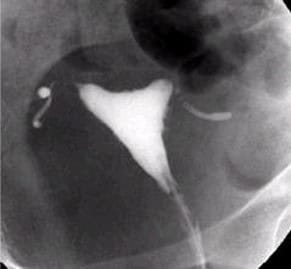If you are experiencing infertility, don’t wait to see a fertility specialist. Sometimes a simple, non-surgical diagnostic tool, such as an HSG X-ray, can give you the answers you need to take control of your fertility.
Hysterosalpingogram (HSG) is a radiology procedure that can help determine the cause of female infertility. An HSG can:
- diagnose Fallopian tube blockages,
- uterine fibroids,
- congenital abnormalities in the uterus,
- polyps,
- and uterine scar tissue that may be hindering conception.
What happens during an HSG X-ray?
The test is typically performed in the radiology department of a hospital, however we provide it on-site. You’ll lie on a table as you would for a regular PAP test, and a speculum is inserted into your vagina. A water- or oil-based contrast solution is injected through the cervix into the uterus. This path of this liquid contrast is what will show up on the x-ray image, indicating any blockages or anomalies.
During a normal HSG result –
The image will show the funnel-shaped uterus filled with fluid, with the fluid passing through both the left and right Fallopian tubes and spilling out into the abdominal cavity.
During an abnormal result –
The fluid will stop at a blockage in the tube, or if the blockage is at the ovary end of the tube, it will fail to spill out into the abdominal cavity. In cases of uterine fibroids, polyps, or scarring, the x-ray will show the fluid moving around the edges of the obstructions.
In a small percentage of patients, the flushing of the tubes with fluid during HSG actually clears an obstruction, increasing their chances of getting pregnant after the procedure.



